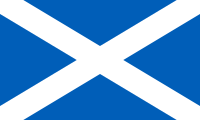Catholic Church in Scotland
Saint Columba | |
|---|---|
| Origin | c. 200s: Christianity in Roman Britain c. 400s: Medieval Christianity |
| Separations | Church of Scotland |
| Members | 841,053 (2011)[1] |
| Official website | bcos.org.uk |
| Part of a series on the |
| Catholic Church by country |
|---|
 |
|
Catholicism portal |
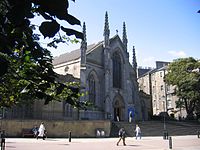
The Catholic Church in Scotland (
In 1716,
Many Scottish Roman Catholics are the descendants of
The Gàidhealtachd has been both Catholic and Protestant in modern times. A number of Scottish Gaelic-speaking areas, including Barra, Benbecula, South Uist, Eriskay, and Moidart, are mainly Catholic. (See also the "Religion of the Yellow Stick".)
Similarly to iconic Pre-Reformation Scottish poets and writers like
In the
History
Establishment
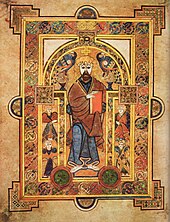
Christianity was probably introduced to what is now lowland Scotland from Roman soldiers stationed in the north of the province of
Medieval Catholicism
In the Norman period the Scottish church underwent a series of reforms and transformations. With royal and lay patronage, a clearer parochial structure based around local churches was developed.[15] Large numbers of new foundations, which followed continental forms of reformed monasticism, began to predominate and the Scottish church established its independence from England and developed a clearer diocesan structure, becoming a "special daughter of the see of Rome" but lacking leadership in the form of archbishops.[16] In the Late Middle Ages the problems of schism in the Catholic Church allowed the Scottish Crown to gain greater influence over senior appointments and two archbishoprics had been established by the end of the fifteenth century.[17] While some historians have discerned a decline of monasticism in the Late Middle Ages, the mendicant orders of friars grew, particularly in the expanding burghs, to meet the spiritual needs of the population. New saints and cults of devotion also proliferated. Despite problems over the number and quality of clergy after the Black Death in the fourteenth century, and some evidence of heresy in this period, the church in Scotland remained relatively stable before the Reformation in the sixteenth century.[17]
Scottish Reformation
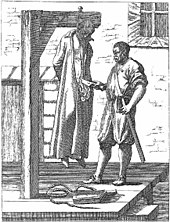
That remained the case until the
Because the
Decline from the 17th century

Numbers probably reduced in the seventeenth century and organisation deteriorated.[23]
The Pope appointed
The aftermath of the failed
According to Bishop
After long and cruel imprisonment with other Catholic priests at
According to Marcus Tanner, "As the
Exact numbers of communicants are uncertain, given the illegal status of Catholicism. In 1755 it was estimated that there were some 16,500 communicants, mainly in the north and west.[25] In 1764, "the total Catholic population in Scotland would have been about 33,000 or 2.6% of the total population. Of these 23,000 were in the Highlands."[32] Another estimate for 1764 is of 13,166 Catholics in the Highlands, perhaps a quarter of whom had emigrated by 1790,[33] and another source estimates Catholics as perhaps 10% of the population.[33]
According to Marcus Tanner, "the
Impact of the Clearances
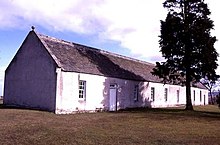
While most of the landlords responsible for the Highland Clearances did not target people for ethnic or religious reasons,[35] there is evidence of anti-Catholicism among some of them.[36][37][38][39][40][41][42] In particular, large numbers of Catholics emigrated from the Western Highlands in the period 1770 to 1810 and there is evidence that anti Catholic sentiment (along with famine, poverty and rising rents) was a contributory factor in that period.[43][44] In Glengarry County, Upper Canada, a colonial settlement was established for Scottish Catholic immigrants through the efforts of bishop Alexander Macdonnell. The settlement's inhabitants consisted of members of the Glengarry Fencibles, a disbanded Catholic unit of the Highland Fencible Corps, and their families.[45][46]
After receiving his post following the 1878 Restoration of the Hierarchy and during the last decade of the Clearances, Bishop
According to Roger Hutchinson, Bishop MacDonald's choice to assign Gaelic-speaking priests from the Scottish mainland to parishes in the
Large-scale Catholic immigration
During the 19th century,
Sectarian tensions
Mass immigration to Scotland saw the emergence of sectarian tensions. Although the interwar Catholic community in Scotland was overwhelmingly working-class and endangered by poverty and economic crises, it was able to cope with the Great Depression.[51] This relative immunity was caused by the Education (Scotland) Act 1918, which made Catholic schools fully state-funded. Michael John Rosie argues that in addition to state-funded education, it was the nature of Scottish Catholicism that "made it less vulnerable to economic dislocation":
Arguably, the Catholic Church was the best-equipped denomination in tackling the adverse effects of economic depression, and does not seem to have suffered serious losses arising from recessionary periods. The Catholic faith is often seen as being invigorated by the combined effects of poverty and discrimination; priests tended to be drawn from the working classes and to relate well to economic hardship amongst their parishioners. Though Catholics moved increasingly during this period into skilled and white-collar jobs, the Catholic community retained a homogeneity which prevented a major social divide emerging between a practising Catholic bourgeoisie and a lapsed proletariat.
— Michael John Rosie, Religion and Sectarianism in Modern Scotland, (2001), pp. 142
This relative economic stability allowed the Catholic community to enter the political and social life of Scotland, sparking outrage among anti-Catholic and unionist circles, most notably the Orange Order. Sectarian violence in Scotland reached its peak in the early 1930s, and Catholic processions were frequently interrupted by anti-Catholic and Orange mob. The Orange Order frequently staged provocative marches in Catholic neighbourhoods. The violence and skirmishes steadily escalated and had a profound effect on Scotland as a whole; Rosie remarked that "the level and scale of the violence exhibited between 1931 and 1935 of a much more serious and concerted nature than of any period since the reintroduction of Orange parades in the 1870s".[52] Sectarian violence was so severe that it caused high policing costs, and local councils were tempted to ban all "religious and pseudo-religious processions". While eventually no such ban took place, tight restrictions were introduced in order to minimise anti-Catholic violence.[53]
In 1923, the Church of Scotland produced a (since repudiated) report, entitled The Menace of the Irish Race to our Scottish Nationality, accusing the largely immigrant Catholic population of subverting Presbyterian values and of spreading drunkenness, crime, and financial imprudence. Rev. John White, one of the senior leadership of the Church of Scotland at the time, called for a "racially pure" Scotland, declaring "Today there is a movement throughout the world towards the rejection of non-native constituents and the crystallization of national life from native elements."[54]
Such officially hostile attitudes started to wane considerably from the 1930s and 1940s onwards, especially as the leadership of the Church of Scotland learned of what was happening in
Social change and communal divisions
In 1986, the General Assembly of the Church of Scotland expressly repudiated the sections of the Westminster Confession directly attacking the Catholic Church.[57] In 1990, both the Church of Scotland and the Catholic Church were founding members of the ecumenical bodies Churches Together in Britain and Ireland and Action of Churches Together in Scotland; relations between denominational leaders are now very cordial. Unlike the relationship between the hierarchies of the different churches, however, some communal tensions remain.
The association between football and displays of sectarian behaviour by some fans has been a source of embarrassment and concern to the management of certain clubs. The bitter rivalry between
From the 1980s the UK government passed several acts that had provisions concerning sectarian violence. These included the
57% of the Catholic community belong to the manual
The Catholic Church recognises the separate identities of Scotland and England and Wales. The church in Scotland is governed by its own hierarchy and bishops' conference, not under the control of English bishops. In more recent years, for example, there have been times when it was especially the Scottish bishops who took the floor in the United Kingdom to argue for Catholic social and moral teaching. The presidents of the bishops' conferences of England and Wales, Scotland, and Ireland meet formally to discuss "mutual concerns", though they are separate national entities. "Closer cooperation between the presidents can only help the Church's work", a spokesman noted.[64]
Scottish Catholics strongly supported the Labour Party in the past, and Labour politicians openly courted Catholic voters and accused their opponents such as the Scottish National Party of opposing the existence of Catholic schools. Scottish Catholics increasingly started identifying with Scottish nationalism in the 1970s and 1980s, and switched to the SNP as their preferred party.[62] Scottish Catholics also emerged as a staunchly pro-independence group – according to a 2020 poll, 70% of Scottish Catholics supported Scottish independence.[62] In 2013, Scottish sociologist Michael Rosie noted that "Catholics were actually the religious sub-group most likely to support an independent Scotland in 1999. This remains true in 2012."[65] Scottish Catholics are also more likely to be in favour of Scottish independence and to support SNP than non-religious voters.[65]
Organisation
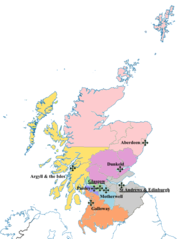
There are four entities that encompass Scotland, England, and Wales.
- The Bishopric of the Forces serves all members of the British Armed Forcesthroughout the world, including those stationed on bases in Scotland.
- The liturgical language.
- The Ukrainian Catholic Eparchy of the Holy Family of Londonserves members of the Ukrainian Catholic Church, a sui juris ritual church of Byzantine Rite that is part of the larger Catholic Church.
- The Syro-Malabar Catholic Eparchy of Great Britain serves members of the Syro-Malabar Church.
There are two Catholic
The Bishopric of the Forces and the Personal Ordinariate of Our Lady of Walsingham are directly subject to the Holy See. The Ukrainian Catholic Eparchy of the Holy Family of London and the Syro-Malabar Catholic Eparchy of Great Britain was subject to their own metropolitans, major archbishops, and major archiepiscopal synods.
21st century

Between 1982 and 2010, the proportion of Scottish Catholics dropped 18%, baptisms dropped 39%, and Catholic church marriages dropped 63%. The number of priests also dropped.[75] Between the 2001 UK Census and the 2011 UK Census, the proportion of Catholics remained steady while that of other Christians denominations, notably the Church of Scotland dropped.[76][77][78]
In 2001, Catholics were a minority in each of Scotland's 32 council areas but in a few parts of the country their numbers were close to those of the official Church of Scotland. The most Catholic part of the country is composed of the western Central Belt council areas near Glasgow. In Inverclyde, 38.3% of persons responding to the 2001 UK Census reported themselves to be Catholic compared to 40.9% as adherents of the Church of Scotland. North Lanarkshire also already had a large Catholic minority at 36.8% compared to 40.0% in the Church of Scotland. Following in order were West Dunbartonshire (35.8%), Glasgow City (31.7%), Renfrewshire (24.6%), East Dunbartonshire (23.6%), South Lanarkshire (23.6%) and East Renfrewshire (21.7%).
In 2011, Catholics outnumbered adherents of the Church of Scotland in several council areas, including North Lanarkshire, Inverclyde, West Dunbartonshire, and the most populous one: Glasgow City.[79]
Between the two censuses, numbers in Glasgow with no religion rose significantly while those noting their affiliation to the Church of Scotland dropped significantly so that the latter fell below those that identified with an affiliation to the Catholic Church.[80]
At a smaller geographic scale, one finds that the two most Catholic parts of Scotland are: (1) the southernmost islands of the
According to the 2011 UK Census, Catholics comprise 16% of the overall population, making it the second-largest church after the Church of Scotland (32%).[82]
Along ethnic or racial lines, Scottish Catholicism was in the past, and has remained at present, predominantly White or light-skinned in membership, as have always been other branches of Christianity in Scotland. Among respondents in the 2011 UK Census who identified as Catholic, 81% are White Scots, 17% are Other White (mostly other British or Irish), 1% is either Asian, Asian Scottish or Asian British, and an additional 1% is either mixed-race or from multiple ethnicities; African; Caribbean or black; or from other ethnic groups.[83]
In recent years the Catholic Church in Scotland has experienced bad publicity due to statements made by bishops in defence of traditional
In 2003, a Catholic church spokesman branded sex education as "pornography" and now disgraced Cardinal Keith O'Brien claimed plans to teach sex education in pre-schools amounted to "state-sponsored sexual abuse of minors."[86]
There has also been even worse publicity related to the sexual abuse of minors. In 2016, a headteacher and teacher of the St Ninian's Orphanage, Falkland, Fife were sentenced for abuse at the orphanage from 1979 to 1983 when it was run by the
Roughly half of Catholic parishes in the West of Scotland were closed or merged because of a priest shortage and over half have closed in the Archdiocese of St Andrews and Edinburgh.[89][90]
In early 2013, Scotland's most senior cleric, Cardinal Keith O'Brien, resigned after allegations of sexual misconduct were made against him and partially admitted.[91] Subsequently, allegations were made that several other cases of alleged sexual misconduct took place involving other priests.[92]
See also
- Bishops' Wars
- Carfin Grotto
- Catholic Church by country
- Catholic Church in England and Wales
- Catholic Church in Ireland (includes Northern Ireland)
- Catholic Church in the United Kingdom
- Catholic schools in the United Kingdom
- Catholicism in the Western Isles
- Hierarchy of the Catholic Church
- List of Catholic churches in Scotland
- List of monastic houses in Scotland
- Lists of popes, patriarchs, primates, archbishops, and bishops
- Scottish Catholic Observer
- The World, the Flesh, and Father Smith, a novel about the life of a Scottish Catholic priest
References
- ^ "Scotland's Census 2011 – Table KS209SCb"
- ^ Michael Martin, "Sae let the Lord be thankit," The Tablet, 27 June 2009, 20.
- ^ Archdiocese of Edinburgh Archived 6 August 2018 at the Wayback Machine www.archdiocese-edinburgh.com. Retrieved 21 February 2009
- ^ "Immigration and Emigration – Scotland – Strathclyde – Lithuanians in Lanarkshire". BBC. Retrieved 18 December 2011.
- ^ Andrew Collier "Scotland's confident Catholics" Tablet 10 January 2009, pg. 16
- ^ "Census reveals huge rise in number of non-religious Scots (From Herald Scotland)". Heraldscotland.com. 27 September 2013. Retrieved 17 December 2015.
- ^ Tad Turski (1 February 2011). "Statistics". Dioceseofaberdeen.org. Archived from the original on 29 November 2011. Retrieved 18 December 2011.
- ^ "How many Catholics are there in Britain?". BBC News. 15 September 2010. Retrieved 6 March 2013.
- ISBN 0-14-025422-6, p. 184.
- ISBN 0-8091-3894-8, p. 21.
- ISBN 0-7486-0100-7, pp. 82–3.
- ISBN 0-88920-166-8, pp. 77–89.
- ISBN 1-4039-7299-0.
- ISBN 0-7509-2977-4, pp. 67–8.
- ISBN 0-7509-2977-4, pp. 109–117.
- ISBN 1-84384-096-0, pp. 26–9.
- ^ ISBN 0-7486-0276-3, pp. 76–87.
- ISBN 0-7486-0276-3, pp. 120–1.
- ^ ISBN 0-7486-1455-9, pp. 232.
- ISBN 0748602763, p. 133.
- ISBN 1444337327, p. 164.
- ^ John Prebble, Culloden (Pimlico: London, 1961), p. 50.
- ^ ISBN 1-85109-440-7, pp. 416–7.
- ^ ISBN 0712698930, p. 365.
- ^ ISBN 0140136495, pp. 298–9.
- ^ J. Prebble, (1961) Culloden (London: Pimlico, 1963), p. 50.
- ^ Charles MacDonald (2011), Moidart: Among the Clanranalds, Birlinn Press. Page 176.
- ^ Charles MacDonald (2011), Moidart: Among the Clanranalds, Birlinn Press. Pages 176-177.
- ^ Thomas Wynne (2011), The Forgotten Cameron of the '45: The Life and Times of Alexander Cameron, S.J., Print Smith, Fort William, Scotland. Pages 57-94.
- ^ a b "Knights of St. Columba Council No. 1 – Glasgow University". Retrieved 24 March 2020 – via Facebook.
- ^ Tanner 2004, p. 34.
- ^ Toomey, Kathleen (1991). Emigration from the Scottish Catholic bounds, 1770-1810 and the role of the clergy (Thesis). University of Edinburgh School of Divinity.
- ^ a b Lynch, Michael,Scotland, A New History (Pimlico: London, 1992), p. 367.
- ISBN 9780300104646.
- ISBN 9004220542, p. 31.
- ^ Prebble, John (1961) Culloden, Pimlico, London pp. 49–51, 325–326.
- ^ "Appreciation: John Prebble'". The Guardian. 9 February 2001. Retrieved 5 February 2014.
- ^ "The Cultural Impact of the Highland Clearances". Noble, Ross BBC History. 7 July 2008. Retrieved 5 February 2014.
- JSTOR 20852924.
- ^ Prebble, John (1969) The Highland Clearances, Penguin, London p. 137.
- ^ Kelly, Bernard William (1905) The Fate of Glengarry: or, The Expatriation of the Macdonells, an historico-biographical study, James Duffy & Co. Ltd., Dublin pp. 6–11, 18–31, 43–45.
- ^ Rea, J.E. (1974) Bishop Alexander MacDonell and The Politics of Upper Canada, Ontario Historical Society, Toronto pp. 2–7, 9–10.
- ^ Richards, Eric (2008). "Chapter 4, Section VI: Emigration". The Highland Clearances: People, Landlords and Rural Turmoil. Edinburgh: Birlinn Ltd. p. 81.
- ^ Toomey, Kathleen (1991) Emigration from the Scottish Catholic bounds 1770–1810 and the role of the clergy, PhD thesis, University of Edinburgh.
- ^ Kelly, Bernard William (1905) The Fate of Glengarry: or, The Expatriation of the Macdonells, an historico-biographical study, James Duffy & Co. Ltd., Dublin
- ^ Rea, J.E. (1974) Bishop Alexander MacDonell and The Politics of Upper Canada, Ontario Historical Society, Toronto
- ^ John Lorne Campbell's Biography of Fr. Allan MacDonald
- ^ Roger Hutchinson (2010), Father Allan: The Life and Legacy of a Hebridean Priest, Birlinn Limited. Pages 74-188.
- ^ Roger Hutchinson (2010), The Life and Legacy of a Hebridean Priest, Birlinn Limited. Page 75.
- ISSN 0264-0856
- hdl:1842/7178.
- hdl:1842/7178.
- hdl:1842/7178.
- ^ Duncan B. Forrester "Ecclesia Scoticana – Established, Free, or National?" Theology March/April 1999, 80–89
- ^ Kevin Spicer Nazi Priests (DeKalb: Northern Illinois University Press, published in association with Holocaust Memorial Museum, Washington [D.C.], 2008), 12–28, 74–75,95–6,114–24,164–68,175–6,182–92,202,231
- ^ Kevin Spicer Resisting the Third Reich (DeKalb: Northern Illinois University Press, 2004), 139, 149, 175–8.
- ^ E. Kelly, "Challenging Sectarianism in Scotland: The Prism of Racism", Scottish Affairs Vol 42 (First Series), Issue 1, 2003, pp. 32–56, ISSN 0966-0356.
- ^ "Celtic Football Club". Celticfc.net. Archived from the original on 19 October 2013. Retrieved 18 October 2013.
- ^ "Celtic Football Club". Celticfc.net. Archived from the original on 19 October 2013. Retrieved 18 October 2013.
- ^ "Action to tackle hate crime and sectarianism" Archived 2 April 2015 at the Wayback Machine, The Scottish Government, retrieved 30 March 2015.
- ^ Gilfillan, P. (2015) Nation and culture in the renewal of Scottish Catholicism. Open House, 252, page 9: 'Professor David McCrone reported that 57% of Scotland’s Catholics were manual working class, while only 48% of the general population were classified as working class.'
- ^ S2CID 249833363.
- ^ Raymond Bonner "In Scotland, New Leadership Crumbles Old Barrier" The New York Times 28 March 2009, 5.
- ^ "Groundbreaking meeting for presidents", The Tablet, 13 June 2009, p. 38.
- ^ a b Gilfillan, P. (2015) Nation and culture in the renewal of Scottish Catholicism. Open House, 252, pp. 8-10.
- ^ "Scots Catholic – Links". scotscatholic.org.
- ^ Diocese of Aberdeen Statistics
- ^ Diocese of Argyll and The Isles
- ^ Diocese of Dunkeld Statistics
- ^ "Galloway (Latin (or Roman) Diocese) [Catholic-Hierarchy]". catholic-hierarchy.org.
- ^ "Glasgow (Latin (or Roman) Archdiocese) [Catholic-Hierarchy]". catholic-hierarchy.org.
- ^ "Motherwell (Latin (or Roman) Diocese) [Catholic-Hierarchy]". catholic-hierarchy.org.
- ^ "Paisley (Latin (or Roman) Diocese) [Catholic-Hierarchy]". catholic-hierarchy.org.
- ^ Archdiocese of Saint Andrews and Edinburgh
- ^ Alderson, Reevel (14 September 2010). "Strength of the Catholic Church". BBC News.
- ^ Religious Groups Demographics
- ^ "Census reveals huge rise in number of non-religious Scots". HeraldScotland. 27 September 2013.
- ^ "Number of Scottish Catholics on the rise". SCO News. Archived from the original on 7 April 2014. Retrieved 5 April 2014.
- ^ "Religion by council area, Scotland, 2011". Archived from the original on 5 January 2017. Retrieved 1 April 2014.
- ^ Table 2 Changes in religion in Glasgow between 2001-2011
- ^ Scotland's Census Results On-Line (SCROL)
- Herald Scotland, 13 September 2013.
- ^ Scotland's Census 2011. Table LC2201SC – Ethnic group by religion (Spreadsheet). National Records of Scotland.
{{cite report}}: CS1 maint: numeric names: authors list (link) - ^ "Catholic bishop hits out at 'gay conspiracy' to destroy Christianity – News". The Scotsman. Edinburgh. 12 March 2008. Retrieved 18 December 2011.
- ^ "Bishop rejects plans for seven new joint-campus mixed-faith schools – Education". The Scotsman. Edinburgh. 23 July 2004. Retrieved 18 December 2011.
- ^ "Church labels sex education 'pornography' – Education". The Scotsman. Edinburgh. 23 September 2004. Retrieved 18 December 2011.
- ^ McCabe, Grant; Riley, Wilma (22 July 2016). "Two men found guilty of sexually abusing and assaulting boys at St Ninian's". dailyrecord.
- ^ Child abuse inquiry. Day 138 21 June 2019
- ^ "Archbishop urges faithful to resist pessimism ahead of parish closures". Catholic Herald. 30 March 2015.
- ^ McKenna, Kevin (15 March 2014). "Time for good deeds from the dying Catholic church | Kevin McKenna". The Observer.
- ^ Pigott, Robert (25 February 2013). "Cardinal Keith O'Brien resigns as Archbishop". BBC News. Retrieved 18 October 2013.
- ^ Catherine Deveney (7 April 2013). "Catholic priests unmasked: 'God doesn't like boys who cry' | World news | The Observer". The Guardian. London. Retrieved 18 October 2013.
External links
- Bishops' Conference of Scotland
- Facts about Catholics in Scotland
- Catholic Encyclopedia's article on Scotland
- Scottish Catholic Observer
- National Library of Scotland: SCOTTISH SCREEN ARCHIVE (selection of archive films relating to Catholicism in Scotland)

